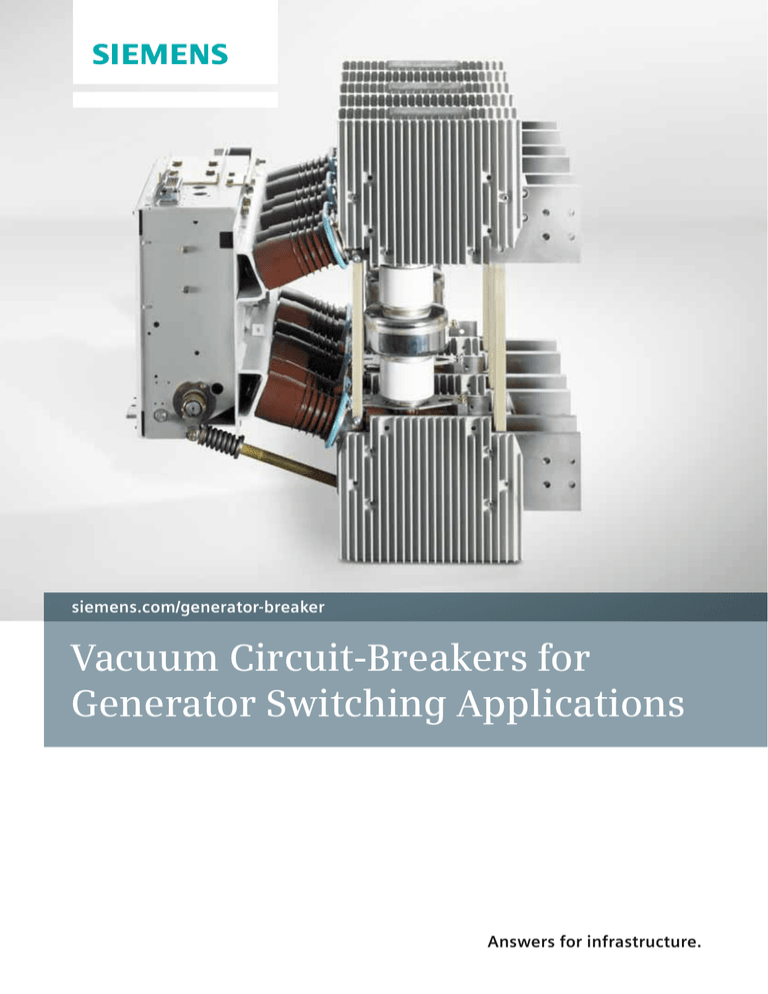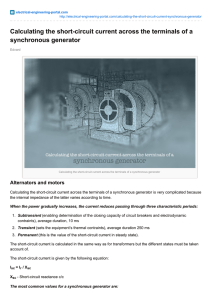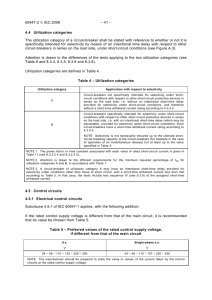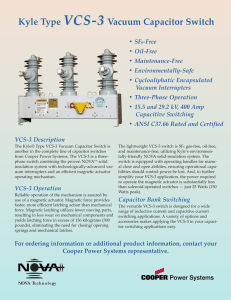
siemens.com/generator-breaker
Vacuum Circuit-Breakers for
Generator Switching Applications
Answers for infrastructure.
Convincing all along the line
Switchgear and switching devices from Siemens
Whether it be vacuum interrupters,
vacuum circuit-breakers, or complete
switchgear assemblies: Siemens
offers the suitable solution for
every requirement.
Grow with your requirements
No question: The worldwide energy
demand will continue to increase rapidly,
placing higher performance requirements
on energy suppliers and industrial
facilities.
■
■
■
■
To provide them with the decisive advantage, Siemens has been constantly developing and improving high-current and
generator circuit-breakers, which are able
to withstand increasingly higher currents.
The top priorities are reliability and maintenance-free design throughout the entire
service life. With comprehensive simulations, preliminary studies, state-of-the-art
development technologies, and modern
manufacturing processes, Siemens sustainably maintains its leading position
in the field of vacuum circuit-breakers.
With Siemens products, the performance,
reliability and economic efficiency of the
entire switchgear assembly grows, and
life-cycle costs are reduced.
Over 40 years of experience
in vacuum switching technology
In particular, Siemens has perfected its
vacuum circuit-breakers for generator
switching applications, where they are
subjected to high thermal and mechanical
stress:
■ Special contact material for minimum
contact wear
■ Specifically developed contact system
2
Optimized design for efficient cooling
Post insulator construction for highest
mechanical stability
Safe breaking operations by controlling
long arcing times even in case of
missing zero crossings
Transient recovery voltages with high
rates-of-rise, typical for generators, are
controlled without additional capacitor
circuits
Application of the proven vacuum switching technology is thus possible with ever
increasing ratings, which formerly had
to be implemented with SF6 switching
technology.
Vacuum switching technology
established on the market
The exceptional economic and technological aspects of the vacuum quenching
principle have made the vacuum circuitbreaker the device that is mostly used
worldwide for voltage ratings from
1 kV to 52 kV.
In the last years, the application of
the vacuum switching technology has
expanded to very high current ratings,
and it is largely accepted even in the
field of generator switching duties.
Siemens offers a wide range of vacuum
circuit-breakers for generator switching.
Features of the
Siemens vacuum switching technology
Constant dielectric
■ The hermetically closed vacuum interrupters are
insensitive to environmental influences
■ Switching processes in the vacuum do not produce
any decomposition products as this is the case with
SF6 circuit-breakers
Constant contact resistance
■ As there is no oxidation in the vacuum,
the contact surfaces remain metallically pure
■ The very small contact resistance prevails
throughout the entire service life
■ Separate main and arcing contacts, such as
required for SF6 circuit-breakers, are not necessary
Suitable for all switching duties
■ Small chopping currents
■ Free of restrikes
■ Breaking of highest normal and short-circuit currents
Economic advantages
■ Vacuum interrupters are maintenance-free
■ Modern vacuum circuit-breakers are maintenance-free
up to 10,000 operating cycles
Advantages of arc extinction
in the vacuum
Vacuum circuit-breakers have a minimum arc power, as there is only contact
material, but no ionisable medium available. The arc already extinguishes at a
minimum contact distance (2–3 mm).
Near current zero, the arc power is not
sufficient to maintain the plasma. The
current is interrupted. With this contact
distance, the dielectric recovery of the
contact gap is enough to assume the
transient recovery voltage.
High reliability of vacuum circuit-breakers
■ Low number of moving parts inside the arcing chamber
■ Extremely high mean-time-to-failure (MTTF) values
of the vacuum interrupters
Minimum use of plastic material
in vacuum circuit-breakers
■ Air is the main insulator
■ Avoidance of creepage paths and partial discharges
Safety first
■ In the extremely unlikely case of loss of vacuum,
only an arc develops, as the current is interrupted
inside a ceramic-metal housing
3
Proven quality from Siemens
Type-tested according to all relevant standards
Type tests as specified in IEC 62271-100 are performed as a rule for
all Siemens circuit-breakers. Generator circuit-breakers are additionally
tested in accordance with IEEE C37.013. This North American
ANSI Standard is the only worldwide standard to take into account
the increased requirements to which the devices are subjected when
switching generators. As a result, ANSI has also become the leading
standard for generator circuit-breakers in IEC-oriented professional
circles.
Standard IEEE C37.013 includes in particular:
■ For generator-side faults: High DC components
and the resulting missing zero crossings
■ For system-side faults: Higher TRV rates-of-rise
■ Higher test voltage levels
Vacuum circuit-breakers for generator switching applications up to 17.5 kV
“Classic” design
“Phase-segregated” design
In
17.5 kV
12,000 A
360 MVA
8,000 A
240 MVA
3AH371
3AH373
6,300 A
180 MVA
3AH375
4,000 A
120 MVA
3AH381
3,150 A
100 MVA
3AK763
40 kA
4
50 kA
63 kA
72 kA
80 kA
90 kA
Ik
3AH37 and 3AH38
Reliable switching capacity up to 90 kA resp.
a rated normal current of 12,000 A
Today, in numerous power supply companies worldwide, the high-current
and generator circuit-breaker 3AH38 is standard for breaking normal currents
up to 4,000 A. It is the first vacuum circuit-breaker with 63 kA and 72 kA to
be type-tested according to the criteria of generator circuit-breaker standard
IEEE C37.013.
Its counterpart for higher generator ratings is 3AH37, the first vacuum circuitbreaker worldwide which can carry a normal current of 6,300 A on a sustained
basis up to 24 kV without forced cooling. Moreover, at a voltage level of 24 kV
it controls short-circuit currents up to 72 kA – with forced cooling, the 3AH37
can be operated with normal currents up to 8,000 A.
Being optimized for interconnected operation, the circuit-breakers can be
used in switchgear with enclosed phases, and flexibly in retrofit business.
Hereby, highest normal currents up to 12,000 A with a short-circuit breaking
capacity of 80 kA, and up to 6,300 A at 90 kA are reached.
Vacuum circuit-breakers for generator switching applications up to 24 kV
“Classic” design
“Phase-segregated” design
In
24 kV
12,000 A
500 MVA
8,000 A
330 MVA
3AH371
3AH374
6,300 A
260 MVA
3AH376
4,000 A
160 MVA
3,150 A
130 MVA
with forced cooling
50 kA
63 kA
72 kA
80 kA
90 kA
Ik
5
3AK763
The compact vacuum circuit-breaker for generator switching applications
Compact design – high performance
Due to its pole shells with a pole-centre
distance of only 210 mm, the 3AK7
combines high mechanical resistance
with a very compact design, and is thus
perfectly suitable for use in compact
switchgear.
As the construction is almost identical
with 3AK7 IEC 50 kA, it offers a profitable opportunity for switchgear manufacturers to cover also smaller generator
switching applications besides the
IEC high-current market. The 3AK763
is designed for 10,000 mechanical operating cycles and type-tested according
to IEEE C37.013.
The 3AK is used, for example,
in the Siemens switchgear type
NXAirP for generator switching.
Rated short-circuit breaking current ISC (3s)
DC component of the rated short-circuit breaking current
[kA]
40
[%]
75
Asymmetrical breaking current
[kA]
58
Rated short-circuit making current
[kA]
110
Generator short-circuit breaking current ISC gen
[kA]
20
[%]
117
DC component of the short-circuit breaking current
Asymmetrical breaking current
Rated currents
[kA]
39
[A]
1,250; 2,000; 2,500; 3,150; 4,000 (with forced cooling)
Rated voltage 17.5 kV (IEC 62271); 15 kV (IEEE C37.013a)
50/60 Hz; Up = 95 kV; Ud = 38 kV
3AK763
Rated operating sequence
– at short-circuit breaking current
CO – 30 min – CO, up to 30 short-circuit breaking operations
Further operating sequences possible:
O – 3 min – CO – 3 min – CO, …
– at normal current
O – 3 min – CO – 3 min – CO, up to 10,000 operating cycles
Up = Rated lightning impulse withstand voltage
6
Ud = Rated short-duration power-frequency withstand voltage
3AH37 and 3AH38
Vacuum circuit-breakers for generator switching applications
Modular design – maximum flexibility
Due to the modular design of the circuitbreaker, the best materials can be used
each for the current path, electric flux
and cooling. Thus, the 3AH37 combines
low resistance of the main circuit with
high mechanical stability and ideal cooling performance.
Moreover, the modular construction
enables even horizontal installation of
the circuit-breaker, if required. To do
this, cooling elements can be installed
that are especially provided for this
mounting position. Thus, the 3AH37
can be operated continuously in every
position without additional fans, reliably
excluding any overheating.
3AH37 and 3AH38 are installed,
for example, in the Siemens
switchgear type HB1.
Rated short-circuit breaking current ISC (3s)
[kA]
50
63
72
[%]
75
65
65
Asymmetrical breaking current
[kA]
73
86
98
Rated short-circuit making current
[kA]
137
173
197
Generator short-circuit breaking current ISC gen
[kA]
DC component of the rated short-circuit breaking current
DC component of the short-circuit breaking current
Asymmetrical breaking current
Rated currents
31.5
36
[%]
110
130
130
110
[kA]
46
52
66
67
[A]
25
3,150; 4,000; 5,000; 6,300; 8,000 (with forced cooling)
Rated voltage 17.5 kV (IEC 62271); 15.5 kV (IEEE C37.013a)
50/60 Hz; Up = 110 kV; Ud = 50 kV
3AH3817 3AH3712 3AH3818 3AH3713 3AH3819 3AH3714
(≤ 4000 A) (> 4000 A) (≤ 4000 A) (> 4000 A) (≤ 4000 A) (> 4000 A)
Rated voltage 24 kV (IEC 62271; IEEE C37.013a)
50/60 Hz; Up = 125 kV; Ud = 60 kV
3AH3722 3AH3722
(≤ 4000 A) (> 4000 A)
3AH3723
3AH3724
Rated operating sequence
– at short-circuit breaking current
CO – 30 min – CO, up to 30 short-circuit breaking operations
Further operating sequences possible:
O – 3 min – CO – 3 min – CO, …
– at normal current
O – 3 min – CO – 3 min – CO, up to 10,000 operating cycles
Up = Rated lightning impulse withstand voltage
7
Ud = Rated short-duration power-frequency withstand voltage
3AH37
The three-circuit-breaker solution for “phase-segregated” design
For generator switching applications
with designs where the phases are
segregated, the requirements for pole
synchronism have been implemented
according to IEC 62271-100, and tested
with short-circuit currents up to 80 kA
and normal currents up to 12,000 A.
The three-circuit-breaker solution is also used as a single-phase enclosed design
in the Siemens switchgear type HB3.
Rated short-circuit breaking current ISC (3s)
[kA]
50
63
72
[%]
75
65
65
65
[kA]
73
86
98
109
Rated short-circuit making current
[kA]
137
173
197
219
Generator short-circuit breaking current ISC gen
[kA]
25
31.5
36
40
[%]
110
130
110
110
[kA]
46
66
67
74
DC component of the rated short-circuit breaking current
Asymmetrical breaking current
DC component of the short-circuit breaking current
Asymmetrical breaking current
Rated currents
[A]
80
4,000; 5,000; 6,300; 8,000; 10,000; 12,000
Rated voltage 17.5 kV (IEC 62271); 15.5 kV (IEEE C37.013a)
50/60 Hz; Up = 110 kV; Ud = 50 kV
3AH3732
3AH3733
3AH3734
3AH3735
Rated voltage 24 kV (IEC 62271; IEEE C37.013a)
50/60 Hz; Up = 125 kV; Ud = 60 kV
3AH3742
3AH3743
3AH3744
3AH3745
Rated operating sequence
– at short-circuit breaking current
– at normal current
Up = Rated lightning impulse withstand voltage
CO – 30 min – CO, up to 30 short-circuit breaking operations
Further operating sequences possible:
O – 3 min – CO – 3 min – CO, …
O – 3 min – CO – 3 min – CO, up to 10,000 operating cycles
Ud = Rated short-duration power-frequency withstand voltage
8
In order to control generator switching applications up to 90 kA, this circuit-breaker was
developed based on the well-known 3AH37
operating mechanism, and an advanced
vacuum interrupter was installed.
Example for a retrofit installation: Replacement of compressed-air
generator circuit-breakers (6 kV – 86.5 kA – 3,500 A)
Rated short-circuit breaking current ISC (3s)
[kA]
DC component of the rated short-circuit breaking current
90
[%]
45
[kA]
107
Rated short-circuit making current
[kA]
247
Generator short-circuit breaking current ISC gen
[kA]
45
[%]
110
Asymmetrical breaking current
DC component of the short-circuit breaking current
Asymmetrical breaking current
Rated currents
[kA]
83
[A]
4,000; 5,000; 6,300
Rated voltage 17.5 kV (IEC 62271); 15.5 kV (IEEE C37.013a)
50/60 Hz; Up = 110 kV; Ud = 50 kV
3AH3756
Rated voltage 24 kV (IEC 62271; IEEE C37.013a)
50/60 Hz; Up = 125 kV; Ud = 60 kV
3AH3766
Rated operating sequence
– at short-circuit breaking current
– at normal current
Up = Rated lightning impulse withstand voltage
CO – 30 min – CO, up to 30 short-circuit breaking operations
Further operating sequences possible:
O – 3 min – CO – 3 min – CO, …
O – 3 min – CO – 3 min – CO, up to 10,000 operating cycles
Ud = Rated short-duration power-frequency withstand voltage
9
More than a good technology
The Siemens performance portfolio – from customer advice to reliable switchgear
Correct selection of the
generator circuit-breaker
Selection criteria are:
■ Rated voltage
■ Rated current
■ System-side short circuit
■ Generator-side short circuit
Design for normal operation
In the vicinity of generators, special
conditions arise. Thus, every application
is specifically adapted to the customer’s
requirements.
Sectional view of a vacuum
interrupter
Basis for the solutions is the application
guide in IEEE C37.013.
The DC component of the generatorside short-circuit current is higher,
which must also be taken into account
for assessment of the breaking capacity.
Overvoltage protection measures
From the view of the vacuum switching
principle, no overvoltage protection
measures are necessary for switching
generators, unless the short-circuit
current of the generator is smaller
than 600 A. However, surge arresters
are usually equipped for this switching
application in order to protect the
expensive generators from all other
overvoltages.
Design for the case of fault
In general, the symmetrical system-side
short-circuit current (case of fault a)
is higher than the generator-side shortcircuit current (case of fault b), and
therefore determines the required
breaking capacity of the generator
circuit-breaker.
In the case of fault, two different fault current components overlap.
The short-circuit current component to be interrupted is supplied by
a) High-voltage system or
b) Generator or
c) High-voltage system and generator
System
transformer
b)
C)
Fault location a: System-side short-circuit
with permanent AC component
Auxiliary
transformer
a)
G
Fault location b: Generator-side short-circuit
with missing zero crossing
10
You know your application.
And we know the behaviour
and features of our switching
devices.
Together we work out the
perfect solution for your
application.
For this purpose, we kindly ask you
to submit the following data:
■ Data sheets of:
– Generator
– Transformer
– Auxiliary transformer & motors,
if applicable
■ Single-line diagram
■ Information on equipment operation,
e.g. interconnected circuits
Based on the information concerning
your application, our experts select a
circuit-breaker which reliably controls
all service conditions, including tripping
in case of fault.
Among other things, the result of the
calculations contains a graphical representation of the current characteristics,
as shown below:
Basic representation of the analysis for the case of fault
Three-phase short-circuit current
Phase T – first-pole-to-clear
isc(t)
(kA)
R
S
T
100
Isc=24.2 kA
80
Isc=20.4 kA
1st zero crossing
60
40
20
Isc=20.2 kA
DC 59%
0
–20
tarc total=11 ms
–40
tarc min=4.4 ms
–60
Contact separation
tcp=49 ms
–80
Time (s)
–100
0.000
0.020
0.040
0.060
0.080
0.100
11
More than 1,300 systems are installed
in generator switching applications
worldwide
Siemens AG
Infrastructure & Cities Sector
Low and Medium Voltage Division
P.O. Box 3240
91050 Erlangen, Germany
For more information, please contact
our Customer Support Center.
Phone: +49 180 524 8437
Fax:
+49 180 524 2471
(Charges depending on provider)
E-mail: support.IC@siemens.com
© Siemens AG 2013
Printed in Germany
TH 260-120542 WS 04131.0
Order No. IC1000-G310-A100-X-7600
All rights reserved.
Trademarks mentioned in this
document are the property
of Siemens AG, its affiliates,
or their respective owners.
Subject to change without prior notice.
The information in this document
contains general descriptions of
the technical options available,
which do not always have to be
present in individual cases. The
required features should therefore
be specified in each individual case
at the time of closing the contract.




